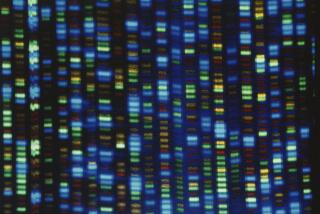Type 1 Diabetes Is Linked to a Flawed Immune System
- Share via
Antibodies and white blood cells called lymphocytes are nature’s front-line soldiers in the defense against disease, but they do not always mount a fair fight.
Sometimes these immune system components play cruel tricks on the very people they are supposed to protect, rendering a person helpless against the aggressiveness of a disease-fighting system gone awry.
Such has been the scenario in rheumatoid arthritis, pernicious anemia and lupus erythematosus.
New studies suggest that an immune system bent on destroying insulin-producing cells in the pancreas may be the cause of type 1 diabetes, which usually begins in childhood and is the most serious but least common kind of diabetes.
Insulin Not Produced
Diabetes is a disorder in which the body does not produce or properly use insulin, a hormone needed to convert sugar and starches into the energy needed for daily life.
The disorder predisposes its victims to atherosclerosis, high blood pressure, kidney failure, coma and blindness. It is blamed on the deaths of more Americans each year than all other diseases except cancer and heart problems.
Type 1, which occasionally is diagnosed in adults, involves the complete shutdown of insulin production and always requires insulin injections to control blood sugar levels. Insulin, however, does not cure the disease or even prevent its life-threatening complications.
The American Diabetes Assn. estimates that about 1 million of the 11 million diabetics in the United States suffer from type 1.
Type 2, however, does not require insulin injections, is most often seen in obese adults and can be controlled with drugs and diet. Scientists are certain that this form of diabetes does not involve an apparent immune system attack on pancreatic cells.
Evidence shows that people who develop the insulin-dependent type of diabetes do so because they inherit a susceptibility. But possession of the genetic vulnerability alone is not enough to trigger the disease.
Scientists are finding that a host of viruses and even toxic substances may prompt the insidious immunologic destruction of pancreatic cells.
“We now have a greater understanding of what causes insulin-dependent diabetes,” said Dr. Mitchell Geffner of the UCLA School of Medicine.
“But despite this new information there are still a lot of gaps in our understanding of diabetes, and there is still no one therapy that can reverse or slow down the disease,” he said.
Doctors who treat children with the disorder say the cellular destruction is so painless that parents are unaware that their children are sick until the symptoms appear--excessive thirst, frequent urination, weight loss and general malaise.
“We now know that the whole evolution of the disease may take many years,” Geffner said. “Usually, by the time symptoms of the disease manifest, the destruction of pancreatic beta cells has been under way for a very long time.”
Blood Sugar Level Soars
Beta cells are involved in the manufacture of insulin. Without them, there can be no insulin production, and without insulin, blood sugar levels soar and diabetes ensues.
The killer immune system cells called lymphocytes and protein antibodies can home in on the islets of Langerhans, groups of cells in the pancreas where beta cells reside and insulin is produced.
Immune system components are attracted to beta cells because they mistakenly recognize them as foreign, destroying them in a process akin to a biological Pac Man that consumes the hormone-manufacturing cells until their population is decimated.
“There’s no question that type 1 diabetes is now very much considered an autoimmune disease,” said Dr. Ronald Kahn, medical director of the Joslin Diabetes Center in Boston.
“All of these patients have antibodies to their own islet cells,” he explained. “So the hope is that if one can catch the disease early in its course and suppress the immune destruction, it will be possible to prevent diabetes from appearing.
Early Detection Stressed
“But, of course, all of this would depend on how early detection and treatment begin.”
Scientists are finding that telltale markers, the genes of certain chromosomes, may be associated with a predisposition to type 1 diabetes.
The markers are found in 95% of all type 1 diabetics. And new studies suggest that millions of Americans--possibly 50% of the entire population--possess these markers, known to scientists as DR3 and DR4.
Dr. Steven Schoenfeld, a diabetes researcher at the University of Washington, Seattle, thinks additional research eventually will produce more specific markers for diabetes.
“The DR3 and DR4 markers are frequently found in people with Graves disease and some forms of arthritis,” he said. “These genes predispose to other autoimmune diseases, so we’re looking for more specific gene markers (for diabetes) that a smaller percentage of the population will have.”
But despite their prevalence, relatively few people who carry the markers develop the disease, and this has led researchers on an aggressive search for viruses and toxins that may trigger immune system stimulation and beta cell decline.
Prevailing scientific wisdom suggests that insulin shutdown occurs in people genetically susceptible to diabetes after one or more exposures to environmental hazards.
“The most commonly implicated environmental factors are in the category of viral infections,” said UCLA’s Geffner, who noted that exposure to certain toxic substances has also been documented in several recent studies.
“The type of virus that can do this, theoretically, is actually a garden variety, everyday type of virus, even one that might have caused a cold in the patient.”
Geffner said the infection triggers an immune response and the slow destruction of beta cells in the pancreas, a process that may take as long as eight years.
Viruses Implicated
Geffner, a pediatrician who specializes in treating diabetic children, said studies of animals with diabetes also strongly implicate viruses as stimulators of the immune system that in turn destroy insulin-producing cells.
Writing in the Western Journal of Medicine, he noted that a strain of the Coxsackie virus, usually associated with meningitis and heart infections, was found during autopsy in the pancreas of a child who had died. When the virus was inoculated into mice, it produced high blood sugar levels.
Growing evidence is providing further confirmation of the role of viruses because 85% of the cases of type 1 diabetes are diagnosed between the months of August and April, the months when certain viral infections are most common.
“In the past, people used to construe the presence of viruses to mean that they were the cause of diabetes,” Geffner said. “But we’re now finding that it’s a lot more complicated than that.”
He said the connection between the calendar and the occurrence of diabetes may relate to the proliferation of respiratory viruses in winter and intestinal viruses that cause vomiting and diarrhea in the summer.
“All infections cause stress,” he said, noting that a single infection may precipitate beta cell destruction. “And a final infection may cause whatever amount of insulin that is left to be used up.”
Supporting the environmental relationship idea is the fact that scientists in Iceland found that a group of boys who ate mutton cured with a nitrosamine compound, a substance similar to the nitrogen-based chemicals used in the United States to cure prepared meats, developed type 1 diabetes.
Evidence also shows that diabetes occurred in people exposed to the rodent killer Vacor, another highly nitrogenous compound, Geffner said.
Dr. George Eisenbarth, chief of immunology at the Joslin Center, said type 1 diabetes is more prevalent among certain nationalities, a factor that could reinforce theories of genetic and environmental relationships.
Differences Between Countries
“Japan’s incidence rate of type 1 diabetes is one-tenth that of the United States. But in Finland the rate is three times as high,” Eisenbarth said. “This could be a result of either genetic or environmental differences.”
To date, diabetes has been treated with insulin and other measures that have tried to control the disorder, but have not been directed toward the basic cause of the condition. Scientists predict that pancreatic cell transplants or even drugs used to suppress the immune system may one day replace insulin injections.
Doctors at the Barbara Davis Childhood Diabetes Center in Denver have transplanted fetal pancreatic islet cells in 24 people in one of the first experiments designed to see if human cadaver tissue will grow, differentiate and produce insulin.
The human trials, which also have been performed at the Washington University medical school in St. Louis, follow successful animal experiments by scientists in Canberra, Australia, and St. Louis.
“The first question we had before beginning this experiment was, ‘Does this tissue have the capacity to grow and differentiate?’ And the answer appears at the moment to be yes,” said Dr. Kevin Lafferty, Barbara Davis research director.
“We’ve been able to show that growth and differentiation is very slow, about three to four months, and these patients are on insulin all the time,” he said.
Lafferty said the second question in the experiment, which involves patients ranging from their mid-20s to early 30s, is whether the transplant will actually control diabetes.
“We’re not sure at this stage, but we can say that a fair proportion of these patients have reduced their insulin intake, some by as much as 50%,” he said. “We don’t have any objective evidence yet that they are making insulin, but so far things appear encouraging.”
The two dozen patients participating in the experiment were all admitted to the hospital for kidney transplants because complications of their diabetes had severely damaged the kidney function.
“It’s important that people know that this is experimental,” Lafferty said. “We have not cured diabetes.”
Anti-Rejection Drug
Meanwhile, recent studies in the United States and France of patients with type 1 diabetes showed that administration of cyclosporine, an anti-rejection drug often used in organ transplants, produced a favorable effect.
But Geffner said use of immune suppressant drugs also raises ethical questions centering on treating patients with therapeutic agents that have the potential of inducing cancer.
“The problem with immune suppressant drugs is that we do not know all of the significant side effects, especially to the kidneys. We also don’t know how long someone would have to be on such medication,” said Dr. Steven Schoenfeld of the University of Washington.






